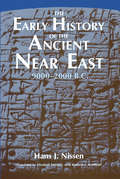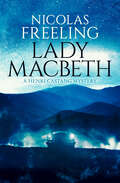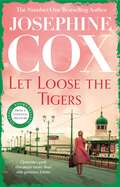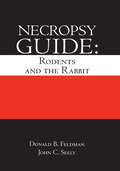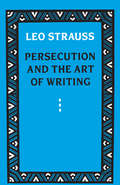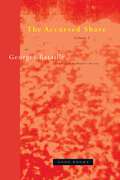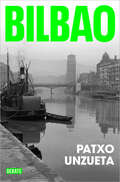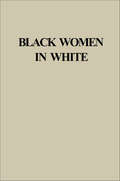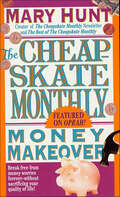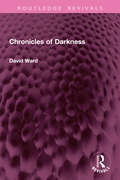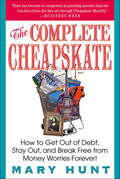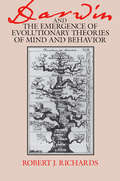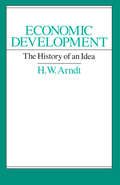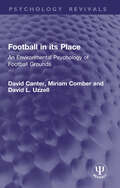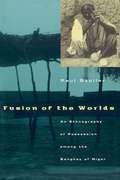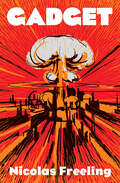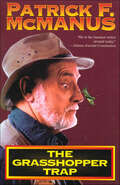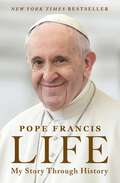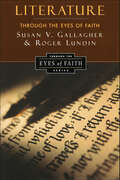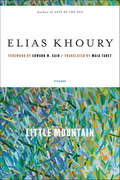- Table View
- List View
The Early History of the Ancient Near East, 9000–2000 B.C.
by Hans J. Nissen Kenneth J. NorthcottHans J. Nissen here provides a much-needed overview of 7000 years of development in the ancient Near East from the beginning of settled life to the formation of the first regional states. His approach to the study of Mesopotamian civilization differs markedly from conventional orientations, which impose a sharp division between prehistoric and historic, literate, periods. Nissen argues that this approach is too rigid to explain the actual development of that civilization. He deemphasizes the invention of writing as a turning point, viewing it as simply one more phase in the evolution of social complexity and as the result of specific social, economic, and political factors. With a unique combination of material culture analysis written data, Nissan traces the emergence of the earliest isolated settlements, the growth of a network of towns, the emergence of city states, and finally the appearance of territorial states. From his synthesis of the prehistoric and literate periods comes a unified picture of the development of Mesopotamian economy, society, and culture. Lavishly illustrated, The Early History of the Ancient Near East, 9000-2000 B.C. is an authoritative work by one of the most insightful observers of the evolution and character of Mesopotamian civilization.
Hegel's Phenomenology of Spirit (Studies in Phenomenology & Existential Philosophy)
by Martin HeideggerThe text of Martin Heidegger's 1930-1931 lecture course on Hegel's Phenomenology of Spirit contains some of Heidegger's most crucial statements about temporality, ontological difference and dialectic, and being and time in Hegel. Within the context of Heidegger's project of reinterpreting Western thought through its central figures, Heidegger takes up a fundamental concern of Being and Time, "a dismantling of the history of ontology with the problematic of temporality as a clue." He shows that temporality is centrally involved in the movement of thinking called phenomenology of spirit.
The Knockout Artist
by Harry CrewsCrews&’s novel about a boxer with the gift of knocking himself unconscious, with a new foreword by New York Times-bestselling author S. A. Cosby A Penguin ClassicA favorite of longtime Harry Crews fans, The Knockout Artist (1988) portrays Eugene Talmadge Biggs, a young boxer from rural Georgia whose champion rise is diverted by a vulnerability, or gift, for knocking himself unconscious. As he begins to exploit his talents, the notorious Knockout Artist journeys a hero&’s descent into the New Orleans underworld and meets characters who have long since checked their morals at the door. The unforgettable climax shows Crews at his virtuoso best, when Eugene confronts his truth, and sets out to claim his freedom and win his own self-respect.
Lady Macbeth (The Henri Castang Mysteries)
by Nicolas FreelingRenowned French Detective Castang investigates a missing wife and her suspicious husband in this mystery from an Edgar award–winning British crime writer.Guy and Sibille Lebfevre had what most people would call a normal marriage—until they have an argument while on a road trip through the Vosges mountains. Enraged, Sibille gets out of the car, disappearing on the otherwise deserted road, never to be heard from again.Six months later, Guy has not even bothered to look for his wife. When Inspector Castang questions him, Guy claims his wife is too proud to come home. This does not sit right with Castang or anyone close to Sibille, as they all suspect her husband of murdering her. But as Castang soon realizes, no one really knows what happens—or doesn’t happen—between a husband and wife. . . . Praise for Nicolas Freeling:“In depth of characterization, command of language and breadth of thought, Mr. Freeling has few peers when it comes to the international policier.” —The New York Times“Nicolas Freeling . . . liberated the detective story from page-turning puzzler into a critique of society and an investigation of character.” —The Daily Telegraph“Freeling rewards with his oblique, subtly comic style.” —Publishers Weekly“Freeling writes like no one. . . . He is one of the most literate and idiosyncratic of crime writers.” —Los Angeles Times
Let Loose the Tigers: Passions run high when the past releases its secrets (Queenie's Story, Book 2)
by Josephine CoxAs she retraces her steps back north, Queenie threatens to disturb more than one person's future... In the sequel to Her Father's Sins, Josephine Cox writes a captivating saga in Let Loose the Tigers, in which Queenie returns to Blackburn... and to her past. Perfect for fans of Kitty Neale and Rosie Goodwin.Queenie Bedford fled her native Blackburn and the bitter knowledge that she and Rick Marsden, the man she loved, could never marry. But in 1965 she returns north again to stand by her friend Sheila Thorogood, imprisoned for running a brothel with her mother Maisie. Though Rick had vowed to find her, Queenie takes care that he should not know of her whereabouts.The magnificent Edwardian house in Blackpool is sadly neglected - but Queenie moves in with the ailing Maisie, and sets about transforming it into a sparklingly clean, highly respectable guesthouse. Meanwhile, Queenie meets the frail and confused Hannah Jason, locked away years ago for murder, and desperate for news of her long-lost son. As Rick continues his dogged search for Queenie, she sets out to find Hannah's son. But both their enquiries threaten to unlock the cage where crucial secrets have long been held captive. What readers have been saying about Let Loose the Tigers: 'This book was brilliant, once you pick it up you cannot put it down because you need to know what happens next''Keeps you spellbound till the end'
Let Loose the Tigers: Passions run high when the past releases its secrets (Queenie's Story, Book 2)
by Josephine CoxAs she retraces her steps back north, Queenie threatens to disturb more than one person's future... In the sequel to Her Father's Sins, Josephine Cox writes a captivating saga in Let Loose the Tigers, in which Queenie returns to Blackburn... and to her past. Perfect for fans of Kitty Neale and Rosie Goodwin.Queenie Bedford fled her native Blackburn and the bitter knowledge that she and Rick Marsden, the man she loved, could never marry. But in 1965 she returns north again to stand by her friend Sheila Thorogood, imprisoned for running a brothel with her mother Maisie. Though Rick had vowed to find her, Queenie takes care that he should not know of her whereabouts.The magnificent Edwardian house in Blackpool is sadly neglected - but Queenie moves in with the ailing Maisie, and sets about transforming it into a sparklingly clean, highly respectable guesthouse. Meanwhile, Queenie meets the frail and confused Hannah Jason, locked away years ago for murder, and desperate for news of her long-lost son. As Rick continues his dogged search for Queenie, she sets out to find Hannah's son. But both their enquiries threaten to unlock the cage where crucial secrets have long been held captive. What readers have been saying about Let Loose the Tigers: 'This book was brilliant, once you pick it up you cannot put it down because you need to know what happens next''Keeps you spellbound till the end'
Necropsy Guide: Rodents and the Rabbit
by Donald B. Feldman John Curtis SeelyThis laboratory guidebook provides step-by-step procedures that will aid in the dissection and collection of major organs and tissues of the most common species of small animals used in biomedical research. Through extensive use of photographs and illustrations, it guides dissectors through a complete necropsy of each species for the purpose of collecting organs and tissues routinely examined by pathologists. The techniques described enable technicians to perform necropsies on almost any mammal in a precise and logical sequence, and collect tissue properly to avoid diagnostic errors. Morphological differences among the various species are discussed.
Persecution and the Art of Writing
by Leo StraussThe essays collected in Persecution and the Art of Writing all deal with one problem—the relation between philosophy and politics. Here, Strauss sets forth the thesis that many philosophers, especially political philosophers, have reacted to the threat of persecution by disguising their most controversial and heterodox ideas.
The World of Late Antiquity: Ce 150-750 (World of Art #0)
by Peter BrownA remarkable study in social and cultural change that explains how and why the late antique world (circa 150–750CE) came to differ from "classical civilization." The first century CE was one of momentous events: the end of the Roman Empire, the rise of Christianity across Western Europe, and the disappearance of Persia from the Near East. An era in which the most deep-rooted ancient institutions disappeared, creating divergent legacies that are still present today. Renowned historian Peter Brown examines these changes and the reactions to them to show that the late antiquity was an outstanding period of new beginnings with far-reaching impacts. The result is a lucid answer to a crucial question in world history: how the exceptionally homogenous Mediterranean world of the first century CE became divided into the three mutually estranged societies of the Middle Ages: Catholic Western Europe, Byzantium, and the Islamic world. Brown’s remarkable study in social and cultural transformation explains how and why the late antique world came to differ from the "classical civilization" of the Greeks and Romans. Featuring a new preface and updated with color illustrations throughout, The World of Late Antiquity demonstrates that we still have much to learn from this enduring and intriguing period of history.
The Accursed Share, Volume I
by Georges BatailleFrom the acclaimed French philosopher, intellectual, and novelist, a brilliant account of the social and economic costs of civilizationIn this important work, Georges Bataille uses his novel economic theory as the basis for an incisive inquiry into the very nature of civilization. He introduces here his concept of the accursed share, the surplus energy that any system, natural or cultural, must expend; it is this expenditure, according to Bataille, that most clearly defines a society. His examples include sacrifice among the Aztecs, potlatch among the Northwest Coast Indians, military conquest in Islam, and Buddhist monasticism in Tibet.In this way, Bataille proposes a theory of a &“general economy&” based on excess and exuberance that radically revises conventional economic models of scarcity and utility. A brilliant blend of economics and aesthetics, ethics and anthropology, The Accursed Share provides an excellent introduction to Bataille&’s philosophic work. It will be of particular interest not only to readers of his fiction and essays but also to cultural theorists, anthropologists, and economists of all schools.
Bilbao
by Patxo UnzuetaUn deslumbrante retrato de la ciudad de Bilbao. «La gran guía literaria de la ciudad vasca».Juan José Solozábal «Un boxeador aficionado llamado Antonio Gómez Vallés, a quien llamábamos el Púgil, y que trabajaba en la huevería de mi padre, nos llevaba cada día, en bicicleta, al colegio. Nos metía a los dos en un gran cesto de mimbre, de los que entonces se usaban para llevar huevos, lo colocaba sobre la barra de la bici, y así íbamos mi hermano y yo, atravesando todo Bilbao, desde la calle Zabala hasta los Escolapios, cerca ya de la ría. Zabala. Empinada cuesta que asciende desde el puente que cruza sobre las vías del tren hasta las minas de Malaespera, a la izquierda, y el camino de los Mimbres, a la derecha. Y, más arriba, la campa de Zabala y la Media Luna, con su txakolí —había un futbolín—, Torre Urizar, San Adrián y luego Larraskitu. En unas casas que construyeron donde antes estuvo la campa de la Media Luna vivió hasta su muerte el poeta Gabriel Aresti. Allí lo visité varias veces en mis años de estudiante. Discutidor nato, casi siempre estaba en desacuerdo con todo el mundo. Pero a mí, que entonces era, me parece, junto con Xabier Kintana, el más joven de sus amigos, siempre me trató con cariño. A la izquierda de la calle, justo donde termina el barrio ferroviario, se abren (o abrían: pusieron una tapia) las campas de las minas de Malaespera, que enlazan, por el otro lado, con las de Miravilla, y llegan hasta Bilbao la Vieja. Los más intensos recuerdos de mi niñez están ligados a esas campas. El gato que mi tío Teófilo llevó allí en un saco para matarlo. Los cráteres en que se depositaba la lluvia. Unas rocas donde nos sentábamos a merendar. A mortadela es el sabor que se me sube a la memoria si cierro los ojos». La crítica ha dicho:«Una delicia».Jozé Antonio Zarzalejos «Una conjugación magistral de historia y memoria, razón y sentimiento, sinrazón y heroísmo. Según Unamuno, 'el mundo entero es un Bilbao más grande'. Este libro trata pues sobre todos nosotros. Aunque no seamos del mismo Bilbao».Javier Rodríguez Marcos
Black Women in White: Racial Conflict And Cooperation In The Nursing Profession, 1890-1950 (Blacks in the Diaspora #No.529)
by Darlene Clark Hine" . . . pioneering. . . . This history, as Hine vividly depicts it, sheds light on the development of African-American professionals and offers as well the opportunity to analyze the intersection of race and gender." —The Nation" . . . well-researched and innovative . . . Highly recommended." —Library Journal"The book is full of poignant and sympathetic portraits of black nurses in their dedication and idealism, in their pain and anger at the relentless contempt of white nurses and in their deep concern for their community's health needs. . . . Hine has brilliantly fulfilled an aim other historians have neglected . . . " —The Women's Review of Books"This well-researched book adds breadth and depth to the existing literature on the educational and professional history of black nurses, including the development of black hospitals and training schools in the US. . . . Highly recommended." —Choice" . . . an important book not only because it is a serious effort to analyze nursing history in the context of American racism but also because it offers a vantage point on the experiences of black women at work." —Medical Humanities Review"Darlene Clark Hine has written a thoughtful analysis of the struggles of African Americans striving for professional status and recognition. . . . an illuminating study of the interaction of race and gender in the construction of a professional identity." —The Journal of American HistoryThis pathbreaking study analyzes the impact of racism on the development of the nursing profession, particularly on black women in the profession, during the first half of this century. Hine uncovers shameful episodes in nursing history and probes the nature and extent of racial conflict and cooperation in the profession.
The Cheapskate Monthly Money Makeover: Break Free Of Money Worries Forever
by Mary HuntYou don't need another budget. You need a money makeover that works.Reformed spendthrift and cred-card junkie Mary Hunt successfully turned her finances around. Now, she shares her own techniques, sound financial principles who went from being in the red to having more money, assets, and financial security than they ever dreamed possible.It's all here in this upbeat, user-friendly guide including:A self-diagnosis quiz to help you become lean, mean, and in controlThe amazing single step that will transform your financial situationA customized rapid-repay plan for debtsPractical, nearly, pain-free daily spending controlsBest tips from The Cheapskate Monthly newsletter for getting the most out of every dollarSpecial help for self-employment, bankruptcy, credit report problems..and more!With Mary Hunt's phenomenal tips, you can get into great financial shape!
Chronicles of Darkness (Routledge Revivals)
by David WardFirst published in 1989, Chronicles of Darkness is about images of Africa seen through the eyes of writers, visitors, residents, and native-born. They range from Joseph Conrad and Olive Schreiner, through Laurens van der Post, Karen Blixen and Evelyn Waugh, to more recent writers like Nadine Gordimer, Andre Brink and J.M. Coetzee.Such writers have frequently been faced with feelings of alienation, marginality, exile, self-consciousness, and egoism. It is only in this sense- that the eyes which see are shadowed and troubled- that Africa is a ‘dark continent’ and that these writings are ‘chronicles of darkness’. In some cases, Africa, even if merely a backdrop painted in crude and garish colors, becomes a way of revealing or admitting something about ‘Europe’ which might be concealed when a writer performs in a different theatre. This is an interesting read for scholars and researchers of English literature and African studies.
The Complete Cheapskate: How to Get Out of Debt, Stay Out, and Break Free from Money Worries Forever
by Mary HuntIn need of a Money Makeover? Let America's most popular cheapskate show you how to go from financial chaos to freedom and security--painlessly and in less time than you ever imagined. Mary Hunt has helped thousands live a debt-free life with her popular newsletter, "The Cheapskate Monthly." In The Complete Cheapskate, Mary puts all the very best money advice she has in one place. Becoming a classy, dignified cheapskate is not all that difficult, and Mary shows how with her user-friendly principles of saving, restraint, and living debt-free. This book will teach you how to: - Create--and stick to--a monthly spending plan - Live well off 80% of your income - Climb out--and stay out--of debt's hole - Stretch every dollar to its absolute maximum - Manage savings and investments - Lower bills on clothes, food, and gifts without lowering living standards - Live within a financial plan that includes a margin for fun and spontaneityWith hundreds of tips on cutting expenses, The Complete Cheapskate is the indispensable guide for people ready to regain control of their finances, relieve the stress money has created, and prepare for their future.
Darwin and the Emergence of Evolutionary Theories of Mind and Behavior (Science And Its Conceptual Foundations Ser.)
by Robert J. RichardsWith insight and wit, Robert J. Richards focuses on the development of evolutionary theories of mind and behavior from their first distinct appearance in the eighteenth century to their controversial state today. Particularly important in the nineteenth century were Charles Darwin's ideas about instinct, reason, and morality, which Richards considers against the background of Darwin's personality, training, scientific and cultural concerns, and intellectual community. Many critics have argued that the Darwinian revolution stripped nature of moral purpose and ethically neutered the human animal. Richards contends, however, that Darwin, Herbert Spencer, and their disciples attempted to reanimate moral life, believing that the evolutionary process gave heart to unselfish, altruistic behavior. "Richards's book is now the obvious introduction to the history of ideas about mind and behavior in the nineteenth century."—Mark Ridley, Times Literary Supplement "Not since the publication of Michael Ghiselin's The Triumph of the Darwinian Method has there been such an ambitious, challenging, and methodologically self-conscious interpretation of the rise and development and evolutionary theories and Darwin's role therein."—John C. Greene, Science "His book . . . triumphantly achieves the goal of all great scholarship: it not only informs us, but shows us why becoming thus informed is essential to understanding our own issues and projects."—Daniel C. Dennett, Philosophy of Science
Economic Development: The History of an Idea
by H.W. Arndt"Economic Development makes an important contribution of the literature on economic development, especially as it incorporates ideas on a theme that informs our concern for social justice, individual and social freedom, identify, and community."—Winston E. Langley, Annals of the American Academy of Political and Social Science
Football in its Place: An Environmental Psychology of Football Grounds (Psychology Revivals)
by David Canter David L. Uzzell Miriam ComberIn the late 1980s football was in a state of crisis. Falling attendances and a genuine unease among potential spectators about going to live football matches suggested that, without radical changes, the game would soon become a minority spectator sport. Originally published in 1989, reissued now with a new preface, Football in its Place presented a new approach to the problem that concentrates on the spectators’ experience of football and on the places where it is played.This approach recognizes four themes, which relate directly to the spectators’ experience: spectator comfort; the need for effective crowd control; the problems of coping in emergencies; and variations in club cultures. A special chapter on football-related violence shows how this needs to be understood in relation to all of these themes and not treated as a problem in isolation. This was said to be the only way to reverse the spiral that had given rise to hooliganism.Finally, the authors discuss the options for the future on football. They emphasize that football is a recreational activity whose management should be treated as part of the leisure industry. All aspects of the game, its traditions, club variations and heritage, needed to be harnessed if football was again to be Britain’s most popular spectator sport. Today we can see the impact that the points made in this book have contributed to how we continue to watch and enjoy football now.
Fusion of the Worlds: An Ethnography of Possession among the Songhay of Niger (None Ser.)
by Paul Stoller"This ethnography is more like a film than a book, so well does Stoller evoke the color, sight, sounds, and movements of Songhay possession ceremonies."—Choice "Stoller brilliantly recreates the reality of spirit presence; hosts are what they mediate, and spirits become flesh and blood in the 'fusion' with human existence. . . . An excellent demonstration of the benefits of a new genre of ethnographic writing. It expands our understanding of the harsh world of Songhay mediums and sorcerers."—Bruce Kapferer, American Ethnologist "A vivid story that will appeal to a wide audience. . . . The voices of individual Songhay are evident and forceful throughout the story. . . . Like a painter, [Stoller] is concerned with the rich surface of things, with depicting images, evoking sensations, and enriching perceptions. . . . He has succeeded admirably." —Michael Lambek, American Anthropologist "Events (ceremonies and life histories) are evoked in cinematic style. . . . [This book is] approachable and absorbing—it is well written, uncluttered by jargon and elegantly structured."—Richard Fardon, Times Higher Education Supplement "Compelling, insightful, rich in ethnographic detail, and worthy of becoming a classic in the scholarship on Africa."—Aidan Southall, African Studies Review
Gadget
by Nicolas FreelingFrom an Edgar award winner, this thriller about a physicist forced to make an A-bomb is &“a splendid account of the excesses of science and bureaucracy&” (The New York Times). An American physicist working in Hamburg, Jim Hawkins is on his way home from his job at a German nuclear institute when he is rammed off the road and abducted by terrorists. Drugged and taken to a secret location, he wakes to find himself being held hostage alongside his terrified wife and daughters. With nothing else to do but comply with the terrorists&’ demands, Jim begins to build a weapon powerful enough to destroy the world. The target: a conference in Lake Geneva, where heads of state are meeting, even as news of his abduction has reached the ears of the American president, only to be dismissed as rumor. Will anyone be able to convince the world leaders of the threat in time? &“Freeling moves from straight suspense to a science thriller and keeps his kinkiness intact. . . . Brilliant.&” —Kirkus Reviews, starred review
The Grasshopper Trap
by Patrick F. McManusPatrick F. McManus, the “funniest guy in the Outdoor Life and Field & Stream gang…offers another bag of whimsy in the Great Outdoors”* with The Grasshopper Trap. In this collection of thirty zany stories, spoofing camping, fishing, and other outdoor recreational activities, McManus shares his hilarious wilderness misadventures. From facing an angry bear with an unloaded gun and the folly of running a boat while it’s still on the trailer to not questioning the ingredients found in camp cookout cuisine and the best methods of catching grasshoppers, no one knows how to express Mother Nature’s sense of humor like Patrick F. McManus. “It’s enough to tickle the most rabid member of the National Rifle Association.”—*Kirkus Reviews
Guards! Guards!: A Discworld Novel (City Watch #1)
by Terry Pratchett“Patchett demonstrates just how great the distance is between one- and two-joke writers and the comic masters whose work will be read into the next century.” —LocusMagic, mayhem, and a marauding dragon combine for extraordinary fun in this cheeky Discworld novel from New York Times bestselling author Terry Pratchett.Insurrection is in the air in the city of Ankh-Morpork. The Haves and Have-Nots are about to face off. Again.It’s old news to Captain Sam Vimes of the city’s ramshackle Night Watch. But this time, something is different—the Have-Nots have found the key to a dormant, lethal weapon that even they can’t fully control, and they’re about to unleash a campaign of terror on the city.Long believed extinct, a draco nobilis can now be seen patrolling the skies above Discworld's greatest city. Not only does this unwelcome visitor have a nasty habit of charbroiling everything in its path, but it’s also soon crowned King.Can Vimes, Captain Carrot, and the rest of the Ankh-Morpork City Watch restore order (before it's burned to a crisp)?The Discworld novels can be read in any order but Guards! Guards! is the 1st book in the City Watch collection and the 8th Discworld book.The City Watch collection in order:Guards! Guards!Men at ArmsFeet of ClayJingoThe Fifth ElementNight WatchThud!Snuff
Life: My Story Through History
by Pope FrancisFor the first time, Pope Francis tells the story of his life as he looks back on the momentous world events that have changed history—from his earliest years during the outbreak of World War II in 1939 to the turmoil of today. An extraordinary personal and historical journey, Life is the story of a man and a world in dramatic change. Pope Francis recalls his life through memories and observations of the most significant occurrences of the past eight decades, from the Holocaust to the fall of the Berlin Wall, Videla’s coup in Argentina to the moon landing in 1969, and even the 1986 World Cup in which Maradona scored the unforgettable “hand of God” goal.Here are the frank assessments and intimate insights of a pastor reflecting on the Nazi extermination of the Jews, the atomic bombings of Hiroshima and Nagasaki, the 2001 terrorist attack on America and the collapse of the Twin Towers, the great economic recession of 2008, the Covid-19 pandemic, the retirement of Pope Benedict XVI, and the subsequent conclave that elected him Pontiff. The “pope callejero” recounts these world-changing moments with the candor and compassion that distinguishes him, and offers important messages on major crises confronting us now, including social inequalities, climate change, international war, atomic weapons, racial discrimination, and the battles over social and cultural issues.Translated from the Italian by Aubrey Botsford
Literature through the Eyes of Faith: Christian College Coalition Series (Through the Eyes of Faith)
by Susan V. Gallagher Roger LundinThis comprehensive study, cosponsored by the Christian College Coalition, addresses questions faced by students in introductory literature courses. It examines literature as a form of human action and argues that the reading and writing of literary works provide vital ways for men and women to act as responsible agents in God's world.Building upon the doctrine of Creation, the authors show how the reading of literature helps us to be more effective interpreters of the stories and images we encounter daily. They demonstrate that great works of literature open up a realm of beauty and truth and help us gain an understanding of ourselves, God, and the world.
Little Mountain
by Elias KhouryWritten in the opening phases of the Lebanese Civil War (1975--1990), Little Mountain is told from the perspectives of three characters: a Joint Forces fighter; a distressed civil servant; and an amorphous figure, part fighter, part intellectual. Elias Khoury's language is poetic and piercing as he tells the story of Beirut, civil war, and fractured identity.
